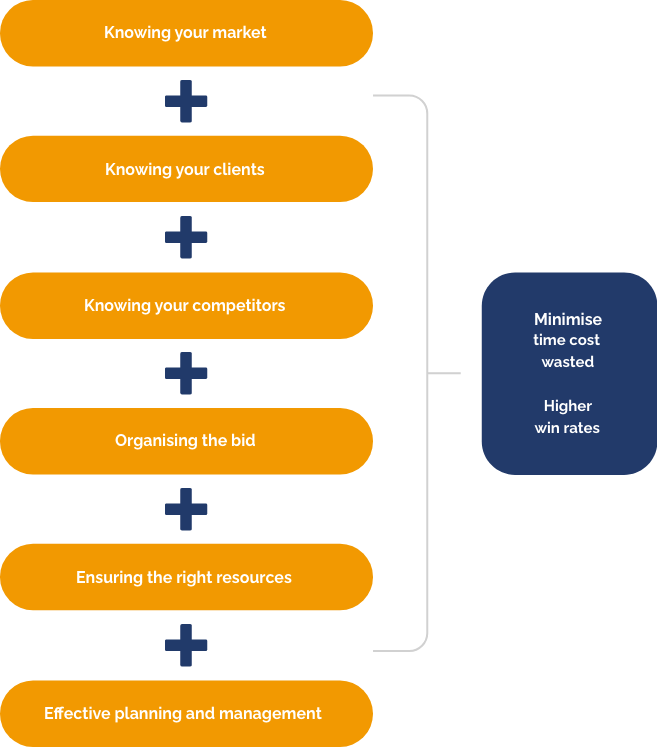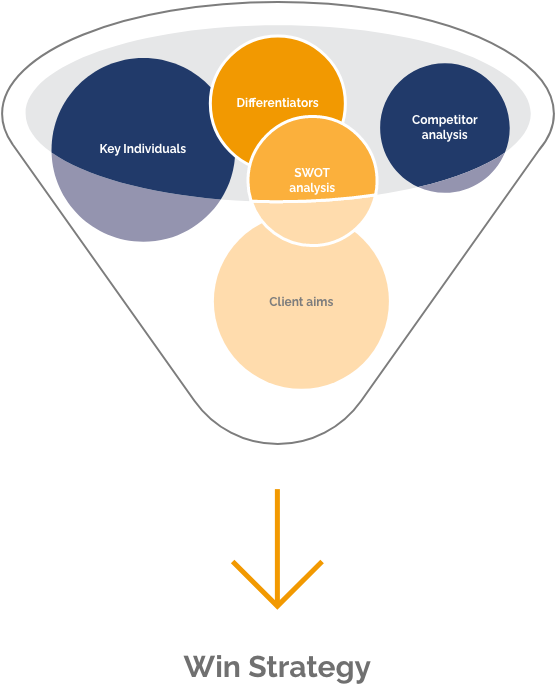If you can properly plan for tenders, it puts you at a real competitive advantage, and can very much be the difference between a successful, and unsuccessful tender submission.
In this resource, we’ll take you through some tender planning tips that can help you succeed.
Creating bid success
There’s no silver bullet when it comes to creating a successful bid.
Here’s a diagram of some of the things required for a successful bid:

Capture planning
Another crucial part of successful tender planning is capture planning, which can involve many different areas of preparation. Here’s what’s involved in effective capture planning…
Market Understanding
This is a sure fire way of gaining an advantage over your competitors, and preparing an effective and contextually sound tender submission.
Here are the main things to consider:
Engage with the market
- Put yourself in the shoes of the ‘buyer’
- Become an expert in your market – read regulatory papers, sector news
Engage with your client
- What is the hierarchy? Who are the decision makers?
- Listen to clients and what they have to say about their challenges
Competitor analysis
Understanding your competitors properly is a fundamental feature of capture planning, and of preparing effectively for a tender.
Make sure to conduct a systematic, staged review with the aim to:
- Understand competitors and establish a differentiation position
- Identify a suitable ‘gap’ in the market to leverage a greater market share
Make sure the analysis is comprehensive – you need to gain a full picture of who you’re up against. Make sure to include:
- Overview and capability
- Key clients / projects
- Adjacent market information
- Strengths and weaknesses
- Accounts information / financial stability
Win strategy
Your win strategy is made up of all of the different areas of the submission that will help you be successful in the tender.
This is crucial for effective tender planning, but first you need to hold a strategy workshop.
This will involve defining differentiators using market and competitor understanding. Then formulate a bid strategy, identifying differentiating factors against the competition.
You should now have a good picture of your win strategy, but here’s a visual representation of what’s included:

Bid development
Bid development is also a crucial facet of successful tender planning. This can be split into two areas – commercial strategies, and supply chain strategies.
Commercial strategies must consider:
- Benchmarking against similar projects
- Lessons learnt
- Call out the client’s commercial approach
Supply chain strategies must consider:
- Delivery model and the known gaps
- Framework of suppliers
- Leverage SME innovations
- Supply chain workshops
- De-risk but don’t break up packages too small
- Fair payment terms and conditions
You also need to make sure you understand the resource required and your budget.
Do not underestimate the level of effort and touch points required during the bid process!
Speak to the experts
As part of our bid support services, we offer support with tender writing and bid management.
With decades of combined experience, a one in two win rate, and an incredibly diverse selection of specialisms – our bid support can help take your tenders to the next level.
Helping your tender planning work smarter, and helping you win more work.
Get in touch with our team today.


